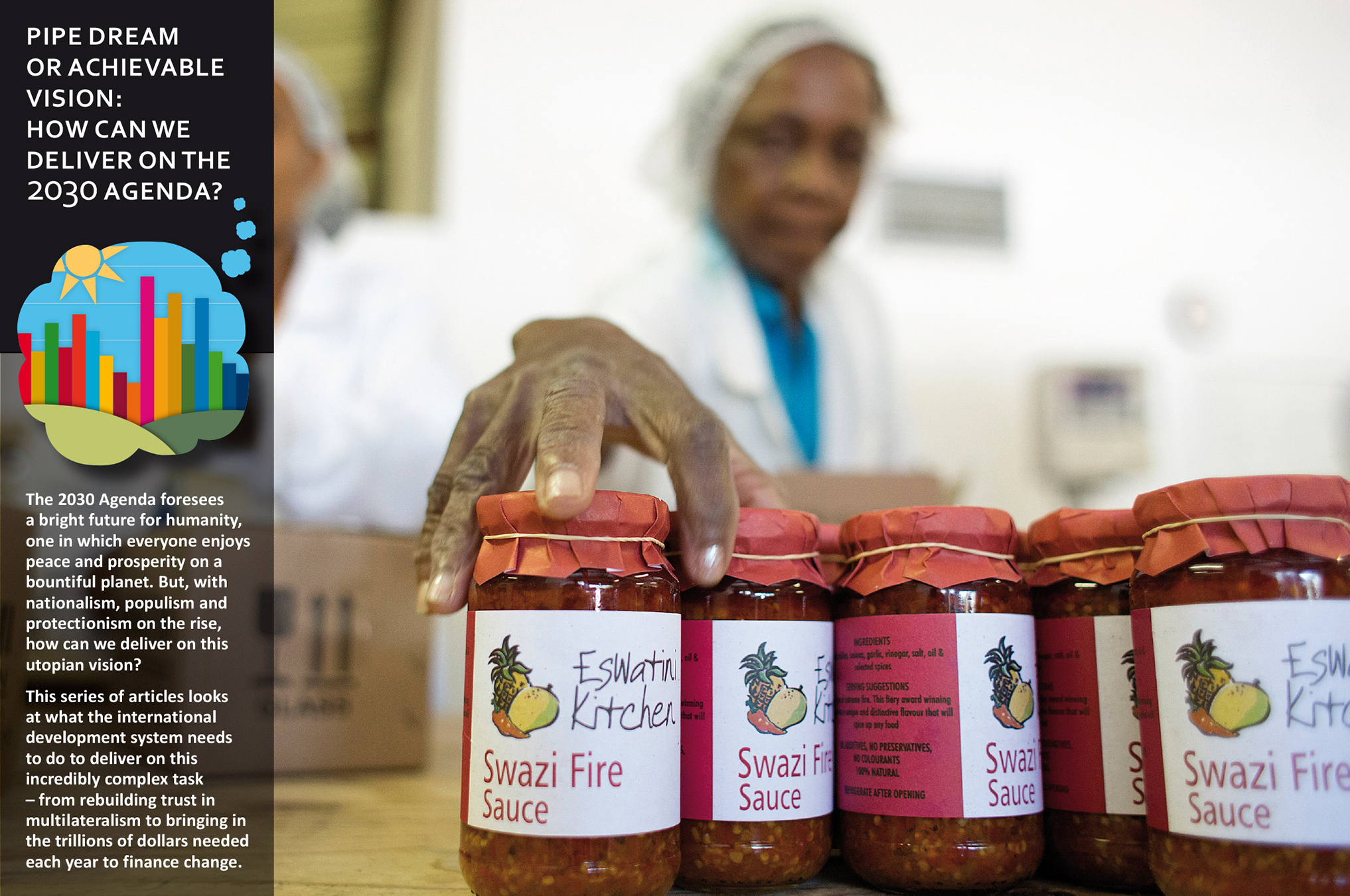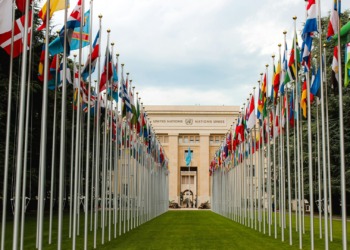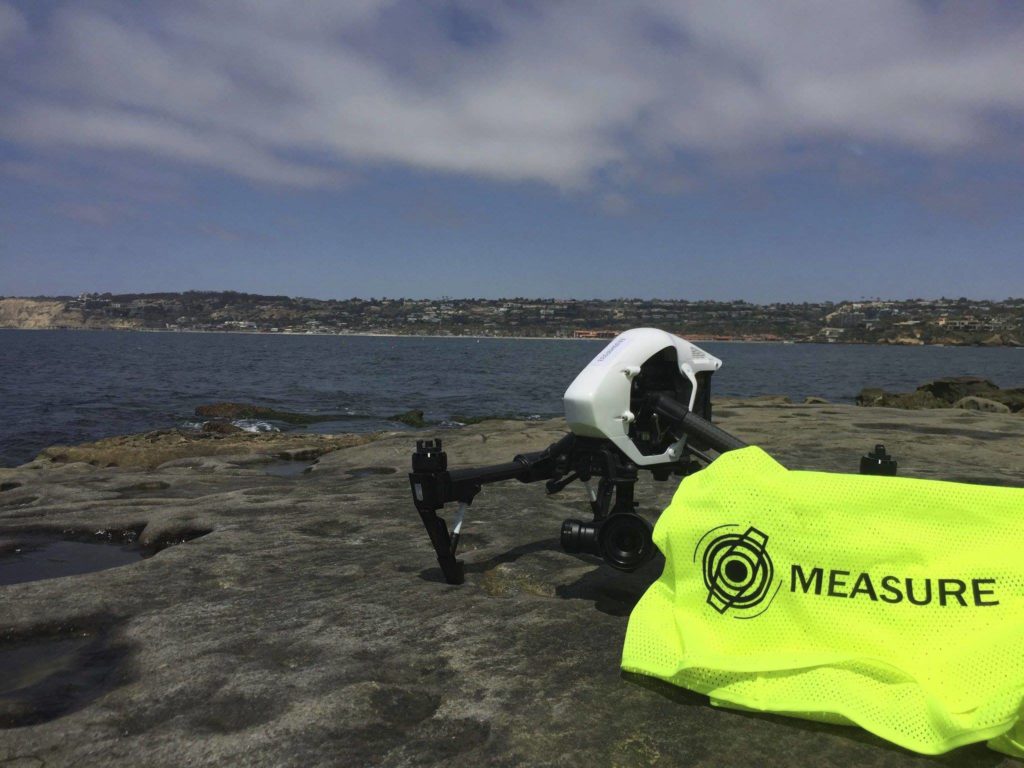SERIES TITLE: Pipe dream or achievable vision: How can we deliver on the 2030 Agenda? The 2030 Agenda foresees a bright future for humanity, one in which everyone enjoys peace and prosperity on a bountiful planet. But, with nationalism, populism and protectionism on the rise, how can we deliver on this utopian vision? This series of articles looks at what the international development system needs to do to deliver on this incredibly complex task – from rebuilding trust in multilateralism to bringing in the trillions of dollars needed each year to finance change. The first article of the series can be found here. The second article of the series – here.
While new financial mechanisms are being tested to bring private capital to bear behind sustainable development, the sector is more than just a money pot. Responsible businesses have been supporting policy development, training, technology transfer, and consultations for quite some time. We are now seeing a move to the next level of engagement as the multilateral system realizes we can’t succeed in our global agendas for change without business fully onboard.
In a sign of the times, the International Chamber of Commerce (ICC) was granted formal UN observer status at the end of 2016. As we work on the Sustainable Development Goals (SDGs), we see no shortage of platforms for public and private sector cooperation. From the World Economic Forum, to the Inclusive Business Action Network, to the UN Global Compact, the proliferation of networks and partnerships suggest that cooperation is growing as fast as the private sector’s awareness of the new global reality of sustainability.
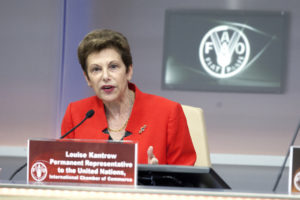
IN THE PHOTO: 114 October 2014, Rome Italy – Louise Kantrow, Permanent Representative to the United Nations, International Chamber of Commerce. Communicating to Inspire Change: Dialogue on Nutrition, FAO Headquarters. CREDIT: FAO/Giuseppe Carotenuto
“There is only one route to meeting the many challenges that face our society – from climate change to mass migration – and that is for governments and civil society to work hand-in-hand with the private sector,” said ICC Chairman Sunil Bharti Mittal as the chamber became an observer. “We stand ready to ensure that the private sector plays a full role in meeting the ambition of the 2030 Agenda.”
Given the many global challenges, such commitment is welcome. For example, with heightened concerns of food insecurity, and a need for increased quality control and socially responsible practices along the food supply chain, working closer with the private sector makes sense. The problem is that many feel cooperation has often been more in the interest of the firm than the beneficiaries. The key question, then, is how to advance cooperation in the most responsible way.
Firstly, we must accept that private firms are self-interested. In many places, listed firms must be self-interested out of a fiduciary responsibility to their shareholders. Also, smart PR has scored enough quick wins in pitching companies as sustainability champions to suggest that many firms do not view deeper investments as necessary.
Building a bridge between the private and public sectors
But there is a middle ground between self-interest and outright philanthropy. By reviewing firms and initiatives holding themselves up as “connectors” between these two worlds, we can see that a joint vision will help mitigate counterproductive actions and ensure that a combined effort is greater than the sum of its parts.
Beyond providing capital, firms can provide training and technical support to develop the workforce, build infrastructure, improve health services, or support economic development by sourcing locally. Aligning these efforts with Official Development Assistance (ODA) streams is complicated, but not impossible.
Let’s start with the Global Compact, which includes businesses in 168 countries. Through their SDG Compass and other efforts, this UN-led initiative to embed ten universal principles in business strategies and conduct has helped focus private sector efforts on the 2030 Agenda. The other goal is to take strategic actions to advance broader societal goals with an emphasis on collaboration and innovation.
Global Compact surveys have shown that 75 percent of companies who join the UN Global Compact initiative are taking action relating specifically to advancing the SDGs. New business opportunities arising from the SDGs include mobility systems, new healthcare solutions, energy efficiency, and affordable housing. The Compact has helped turn the conversation from one of good deeds to one of business interests.
Then there is KPMG, which developed an SDG Industry Matrix to inform private sector action, tailored to specific sectors. Created in collaboration with the Global Compact, the matrix lists opportunities for shared value by sector and SDG. KPMG’s aim is to integrate the SDGs into existing business strategies instead of reinventing the wheel.
There are more: the World Business Council for Sustainable Development (WBCSD) is a group whose focus is to “accelerate the transition to a sustainable world”. It works with 200 leading companies, developing practical resources such as the CEO guide to the SDGs, and supporting Action Platforms with private firms, academia, civil society organizations (CSOs), and the UN Global Compact.
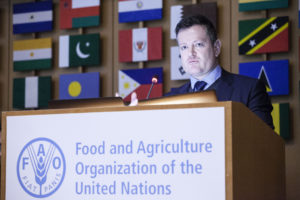
IN THE PHOTO: 12 December 2017, Rome Italy – Metrics for CSA: Outcomes of the GACSA June 2017 Workshop by Matthew Reddy, Director of CSA, World Business Council for Sustainable Development (WBCSD). Plenary Session, Global Alliance for Climate-Smart Agriculture (GACSA) 12-13 December, FAO headquarters. CREDIT: FAO/Giuseppe Carotenu
The workers: cooperation in the real world
While the Compass can help to align strategies with global priorities, direct action can identify future business opportunities, enhance the value of corporate sustainability, and stabilize the societies and markets on which they depend. So, as long-standing development silos are being challenged, what does the private sector foray into international assistance look like
FAO’s Strategy for Partnerships with the Private Sector offers a hint. Noting that risk assessment and monitoring and evaluation are key – along with resource mobilization – there are countless ways to contribute. For example, if a firm wants to address food insecurity, they can help with knowledge management and dissemination, norms and standard setting, development and technical programmes, policy dialogue, and advocacy and communication.
Established development actors can assist governments in enhancing collaboration with the private sector. After all, ODA providers need partners, and emerging donors can foster relationships with leading firms to promote long-term solutions. SDGs cannot – and should not – be pursued only by governments. Each goal has a constituency in the private sector eager to see them achieved.
Public-Private Partnerships have long been touted as a mode of cooperation that can go beyond financing. Private sector expertise can be brought in to inform long-standing development initiatives on agriculture, health, infrastructure, and climate change.
There are too many examples to cite fully. FAO has partnered with Unilever on a program to reduce food loss and waste – starting in Argentina and expanding to the rest of Latin America. IBM and USAID have collaborated on innovative technology centers, including one recently in Armenia. Samsung has partnered with KOICA and GIZ (the South Korean and German international development bodies) to support women professionals in Ghana.

IN THE PHOTO: About 10,000 people are estimated to sell street food in Accra. Ninety percent of them are women.In 2016, FAO Regional Office for Africa (FAR RAF) led an extensive field survey on street food vending in Accra, Ghana, in collaboration with the School of Public Health of the University of Ghana. The survey was aimed at gathering updated and policy relevant information about the sector, enabling public authorities as well as street food vendors and consumers to take informed and data-driven action towards the development of the sector. CREDIT: FAO/Christiana Asantewah
The area of work can depend on the interest of a few corporate actors or can be identified as business opportunities that satisfy both traditional actors and shareholders. Take the concept of “Corporate Disruptors”, who can create an untapped consumer base by reducing poverty, can increase market share and size by addressing gender equality (for instance through equal access to education), or can increase productivity lost through disease by improving water supply quality.
“Business leaders are facing an increasingly complex and volatile world, one with constrained resources, changing demographics, more informed consumers and greater expectations of business,” said Jessica Long, Managing Director, Accenture Strategy, Sustainability Services. “Corporate disruptors reframe challenges around poverty, climate change and inequalities. The more strongly you commit to being a corporate disruptor, the greater the impact you will have on your company, society and the environment around you.”
Enlarging the consumer base may not be the best driver for development, although one could argue that the ends justify the means. Risks exist that this incentive could lead to a misalignment of priorities. Overall, though, when the government and private sector agree on interventions that benefit society as a whole, ODA can promote further investment and involvement of the private sector in society-wide needs, such as protecting the food supply chain.
But the most direct form of engagement can be with host countries themselves on improving public financial management – as a regulatory framework which provides predictable taxation and a competition-enabling environment requires transparency and dialogue with all involved. This is the top of the wish lists of most global companies.
The Extractive Industries Transparency Initiative (EITI) has shown results in this space. EITI works with private sector companies, policy makers, and civil society monitors to implement global standards for tracking and reporting revenue from extractive industries – a common area of corruption. Firms benefit because incentives for bribery and rent-seeking are reduced, civil society benefits by participating in a role that has real teeth, and countries benefit because “lost” revenues find their way back to the treasury. Nigeria, the first country to back up the EITI by law, has claimed up to $2 billion USD in recovered assets as a result.

IN THE PHOTO: Separating coconut meat from husks is done manually. Nothing gets wasted. CREDIT: FAO/Soojin Kim
Small was beautiful, but the future is global
Attempts at corporate social responsibility have long been in play, but it is now high time to harness this thinking in support of the SDGs, particularly since consumers have higher expectations for businesses, and digital technologies are allowing more transparency and interaction.
Firms are invested as well and can provide more than just capital. Collectively, we can work from training one group of farmers to achieving zero hunger, from donating solar panels to confronting climate change, and from providing computers to schools to addressing the roots of inequality and involuntary migration.
As noted in the Addis Ababa Action Agenda, joint programming, and partnerships to improve public financial management, including tax policy and administration, are promising. But how can the competition in the market place be better channeled to support competition for ideas to achieve SDGs? And how can thousands of firms seeking new business opportunities and aligning their individual strategies with the SDGs best be engaged to ensure that cooperation is effective, sustainable, and responsible? This is the conversation we all need to have.
The one thing we know for sure is that we must increase efforts in a systematic and fair manner. After all, the SDGs are historic in their ambition. This call to action requires an equally ambitious response. There is no single model, but cooperation between leading private actors and public development partners can indeed have a lasting impact for humanity and the planet.
The next article in the series will be published on 31/07/2018


